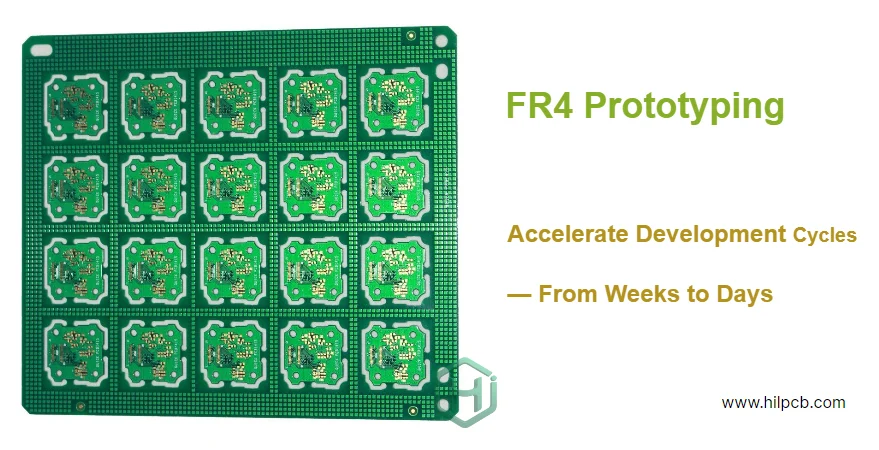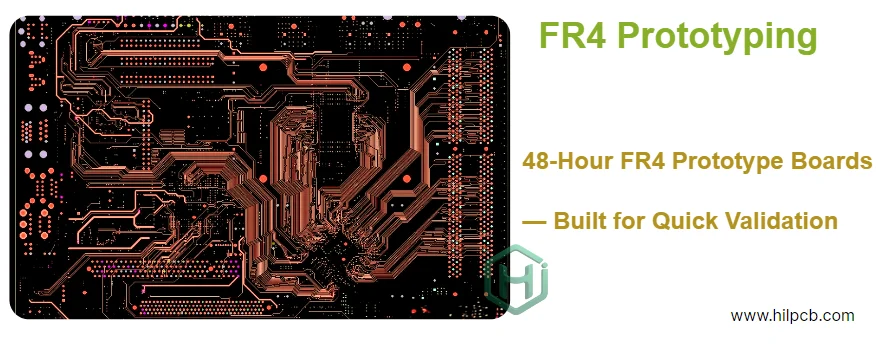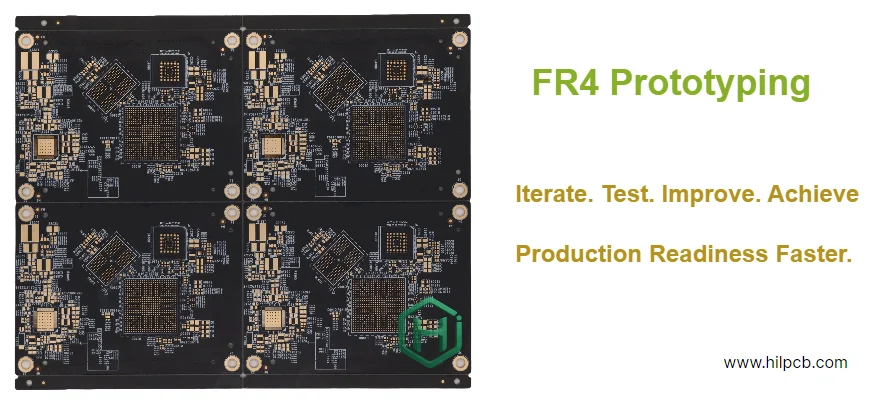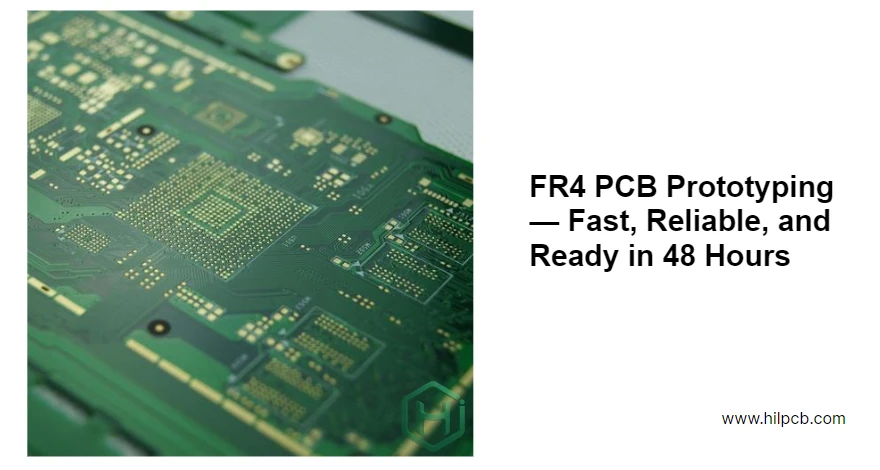Your hardware deadline is approaching. You need assembled FR4 prototypes to validate your design, but standard lead times are 2-3 weeks. That's too slow — by the time you discover design issues, you've lost weeks of development time.
Fast prototyping isn't just about speed — it's about accelerating your learning cycle. Every day waiting for boards is a day you can't test, iterate, and improve. The faster you fail (and fix issues), the faster you reach a production-ready design.
At HILPCB Factory, we've helped thousands of engineers compress development cycles through rapid FR4 prototyping. We understand that prototype PCBs serve a different purpose than production boards, requiring different priorities and trade-offs. This guide explains how to get quality prototypes fast without compromising the insights you need.
Why Speed Matters in FR4 Prototyping
Rapid prototyping isn't a luxury — it's a competitive advantage in hardware development.
The Cost of Slow Prototyping
Extended Development Cycles: Traditional 2-3 week PCB lead times force sequential development:
- Week 1-3: Wait for boards
- Week 4: Discover design issue
- Week 5-7: Wait for revised boards
- Week 8: Discover another issue
- Repeat...
Each iteration consumes 4+ weeks. Three iterations = 12 weeks before production-ready design.
Fast Prototyping Transforms This:
- Day 1-2: Receive first prototype
- Day 3-5: Test and identify issues
- Day 6-7: Receive revised prototype
- Day 8-10: Validate fixes
Three iterations = 2-3 weeks total. You've compressed 12 weeks into 3 weeks — a 75% reduction in development time.
Market Timing Impact: Hardware markets move fast. First-to-market advantages disappear quickly:
- Consumer electronics: 3-6 month product cycles
- Industrial equipment: Annual product refreshes
- Automotive: Model year deadlines (inflexible)
Missing your window by weeks can mean:
- Lost sales opportunities
- Competitor advantage
- Delayed revenue and cash flow
Founder/Engineer Time Value: Your team's time is expensive. Engineers and founders waiting for boards:
- Cannot progress to next development phase
- Context-switching to other projects (inefficient)
- Losing momentum and focus
Fast prototyping keeps teams productive and projects moving.

HILPCB's Rapid FR4 Prototyping Service
We've optimized our small-batch assembly service specifically for development speed.
48-Hour Fabrication Service
How It Works:
- Upload files by noon (your time zone)
- Engineering review within 2 hours — we catch issues immediately
- Fabrication begins same day — prioritized processing
- Boards ship within 48 hours — express shipping available
What's Included:
- 2-8 layer FR4 boards
- Standard thickness (0.8mm-2.0mm)
- 1-2oz copper
- HASL or ENIG surface finish
- Basic electrical testing
- 5-50 board quantities
Cost Trade-offs: Rapid prototyping costs more per board than standard lead time due to:
- Priority processing (displaces normal production)
- Smaller panel utilization
- Expedited material sourcing
- Express shipping
Typical premium: 40-60% vs. standard pricing. But the value proposition is clear — you get results 10 days faster.
What Designs Qualify for 48-Hour Service
Not every design can be rushed. Our rapid service accommodates:
Standard Complexity:
- 2-4 layers (most prototype designs)
- Standard trace/space (5mil/5mil or wider)
- Through-hole vias only
- Common materials (standard or high-TG FR4)
- Standard finishes (HASL, ENIG, OSP)
Complex Designs Requiring Standard Lead Time:
- 6+ layers (multilayer PCB requires extended processing)
- HDI PCB with blind/buried vias
- Thick copper (3-4oz requires longer plating)
- Exotic materials or special processes
- Impedance control (requires additional setup and testing)
We provide immediate feedback on feasibility when you upload files.

Optimizing Your Design for Rapid Prototyping
Smart design choices accelerate prototyping without compromising validation goals.
Design for Speed Trade-offs
Layer Count:
- 2-layer designs: Fastest possible turnaround
- 4-layer designs: Minimal delay vs. 2-layer
- 6+ layers: Requires standard lead time
Strategy: Use minimum layers adequate for prototype functionality. You can add layers for EMI/noise margin in production design after validating core functionality.
Copper Weight:
- 1oz copper: Fastest processing, adequate for most signals
- 2oz copper: Slight delay, necessary for power traces
- 3-4oz copper: Significant delay, avoid unless testing power delivery
Strategy: Use 1oz copper with wider traces for prototype power routing. Test thermal performance with production copper weight in later iterations.
Via Technology:
- Through-hole vias: Fast, no special processing
- Blind/buried vias: Requires sequential lamination (slow)
- Microvias: Laser drilling adds time
Strategy: Prototype with through-hole vias when possible. Blind/buried vias can be added for production optimization after functional validation.
Surface Finish:
- HASL: Fastest, adequate for hand assembly
- OSP: Very fast, good for machine assembly
- ENIG: Slightly slower but excellent for prototypes with multiple assembly passes
Strategy: Use ENIG for prototypes requiring rework or multiple test cycles. Use HASL/OSP only for one-time assembly.
Common Prototype Design Mistakes
Mistake 1: Over-Engineering Prototypes Designers often include production-level optimization in prototypes:
- Extreme miniaturization (tight spacing, small vias)
- Maximum layer count minimization
- Exotic materials for marginal performance gain
Better Approach: Prototype with generous margins. Validate functionality first, optimize for production later. This accelerates prototyping and actually improves debugging by providing test points and access.
Mistake 2: Inadequate Test Access Production designs minimize test points for size/cost. Prototypes need extensive test access:
- Exposed ground points throughout
- Test pads on critical signals
- Easily accessible power rails
- Component-side test access
Better Approach: Add comprehensive test points to prototypes. The cost is negligible and debugging becomes dramatically faster.
Mistake 3: Ignoring DFM Guidelines Some designers push prototypes beyond manufacturability limits:
- Minimum trace widths without margin
- Inadequate spacing near board edges
- Non-standard hole sizes
- Incomplete or missing silkscreen
Better Approach: Follow standard design rules even for prototypes. Our PCB manufacturing team provides DFM guidelines that ensure reliable fabrication.

Beyond PCB Fabrication: Complete Prototype Assembly
Getting bare boards fast is only half the story. Assembly speed determines when you can actually test.
Rapid Assembly Services
Our complete prototyping service includes:
Component Sourcing:
- Same-day component ordering from major distributors
- Alternative component recommendations for unavailable parts
- Consignment acceptance for customer-supplied components
Assembly Process:
- SMT assembly within 24 hours of receiving boards
- Through-hole assembly for mixed technology
- Hand assembly for prototype quantities (faster than setup for automation)
Testing:
- Basic continuity and polarity checks
- Functional testing per customer procedures
- Debug support for issues discovered during test
Total Turnaround:
- PCB fabrication: 48 hours
- Component sourcing: 1-2 days (if not in stock)
- Assembly: 24-48 hours
- Total: 5-7 days from order to working prototypes
Managing Component Lead Times
Components, not PCBs, often become the critical path:
Common Component Delays:
- Specialized ICs: 8-12 week lead times typical
- Custom magnetics: 4-6 weeks
- High-power MOSFETs: 6-10 weeks (depending on market)
- Precision resistors/capacitors: 2-4 weeks
Strategies:
- Order Long-Lead Components Early: Don't wait for PCB arrival to order 12-week components
- Design with Available Parts: Check distributor stock during design phase
- Have Alternates Ready: Identify second-source options before ordering
- Consider Development Kits: Use evaluation boards for initial software development while custom hardware is being built
We help customers navigate component challenges through our extensive distributor relationships and component engineering expertise.
Iterative Prototyping: Building on Learning
Smart teams plan for iteration from day one.
The Multi-Iteration Approach
Iteration 1: Proof of Concept
- Goal: Validate core functionality
- Focus: Does the fundamental approach work?
- Timeline: 5-7 days
- Acceptable trade-offs: Generous layout, test points everywhere, larger size
Iteration 2: Feature Validation
- Goal: Confirm all features work as expected
- Focus: Signal integrity, power delivery, thermal performance
- Timeline: 7-10 days (lessons from iteration 1 incorporated)
- Refinements: Size optimization begins, remove unnecessary test points
Iteration 3: Pre-Production
- Goal: Validate production design
- Focus: Manufacturing margins, cost optimization, reliability testing
- Timeline: 10-14 days (production-equivalent processes)
- Changes: Final size/cost optimization, production materials
Benefits of Planning Iterations:
- Each cycle builds on validated learning
- Risk reduced progressively
- Team maintains momentum
- Cheaper/faster than trying to perfect design in one attempt
Documentation Between Iterations
Capture Learnings:
- Test results and measurements
- Issues discovered and root causes
- Design changes and rationale
- Component performance observations
Design Review Before Next Iteration:
- What worked well? (keep it)
- What problems occurred? (fix them)
- What assumptions were wrong? (adjust approach)
- What can be optimized? (improve efficiency)
We encourage customers to schedule reviews with our engineering team between iterations — external perspective often identifies improvements.

FR4 Prototyping Cost Optimization
Speed costs money, but smart choices maximize value.
When to Choose Express vs. Standard
Express Prototyping (48-72 hours) Best For:
- Critical path project gates
- Investor demos and trade shows
- Last-minute design changes before production
- Fast-moving competitive situations
Standard Prototyping (5-10 days) Best For:
- Early development exploration
- Non-critical design iterations
- Budget-constrained projects
- When components have long lead times anyway
Cost Difference: Express: $200-400 for typical 4-layer prototype (5 boards) Standard: $120-250 for same design Savings: $80-150 (but 7 days slower)
Value Calculation: If your team's loaded cost is $100/hour and this delay affects 2 engineers for 2 days:
- Cost of delay: $100/hr × 8 hrs/day × 2 days × 2 engineers = $3,200
- Express premium: $150
- Net value of express: $3,050
For professional development, express prototyping almost always provides positive ROI.
Quantity Optimization
Optimal Prototype Quantities:
- 5 boards: Minimum for meaningful testing (allows for assembly mistakes)
- 10 boards: Good for multiple test setups or team distribution
- 20+ boards: When prototype will be used for extended validation or field testing
Per-Unit Cost:
- 5 boards: ~$30-80 per board
- 10 boards: ~$20-50 per board
- 20 boards: ~$15-35 per board
Recommendation: Order 10 boards for most prototypes. Provides adequate quantity for testing while maintaining reasonable cost. You can always order more if needed.
HILPCB's Prototype Support Services
Beyond fast fabrication, we provide development support:
Engineering Consultation:
- Pre-order DFM review
- Material selection guidance
- Cost/performance trade-off analysis
- Alternative approaches for challenging designs
Flexible Ordering:
- No MOQ (minimum order quantity)
- Combined orders (multiple designs on one panel)
- Revision tracking and comparison
- Expedited reorders for validated designs
Quality Assurance:
- Same quality standards as production
- 100% electrical testing
- Photo documentation of issues
- Debug support and failure analysis
Transition to Production:
- Design optimization recommendations
- Volume pricing with no setup charges
- Established processes for consistent results
- Large-volume assembly scaling when ready
Frequently Asked Questions
Can I get prototypes faster than 48 hours?
For simple 2-layer designs with customer-supplied components, we can sometimes achieve 24-hour turnaround. Contact us with your specific requirements for evaluation. Be aware that component sourcing, not PCB fabrication, typically limits faster turnaround.
What if I discover issues after ordering prototypes?
We allow design changes up to 4 hours after order placement (before fabrication begins). After that, we can typically accommodate design changes for additional prototype orders with minimal delay since material is already allocated.
Do you charge setup fees for prototype orders?
No setup fees for standard prototype quantities (5-50 boards). Volume production may include one-time tooling charges for fixtures, but these are communicated clearly in quotes and amortized across production runs.
Can you help with design review before ordering?
Yes, upload your design files and we'll provide DFM feedback within 2-4 hours. We identify potential issues, suggest optimizations, and confirm feasibility for your target timeline. This service is complimentary for prototype orders.
What's the difference between your prototype and production processes?
Prototypes use the same equipment and quality standards as production. The difference is prioritization (prototypes jump the queue) and panel utilization (prototypes may not fill entire panels efficiently). Quality and capabilities are identical.
Can prototypes be used for functional testing at extreme conditions?
Yes, our prototypes use production-grade materials and processes. They're suitable for temperature testing, vibration testing, extended burn-in, and other qualification activities. Many customers use our prototypes for initial reliability testing before committing to production tooling.

